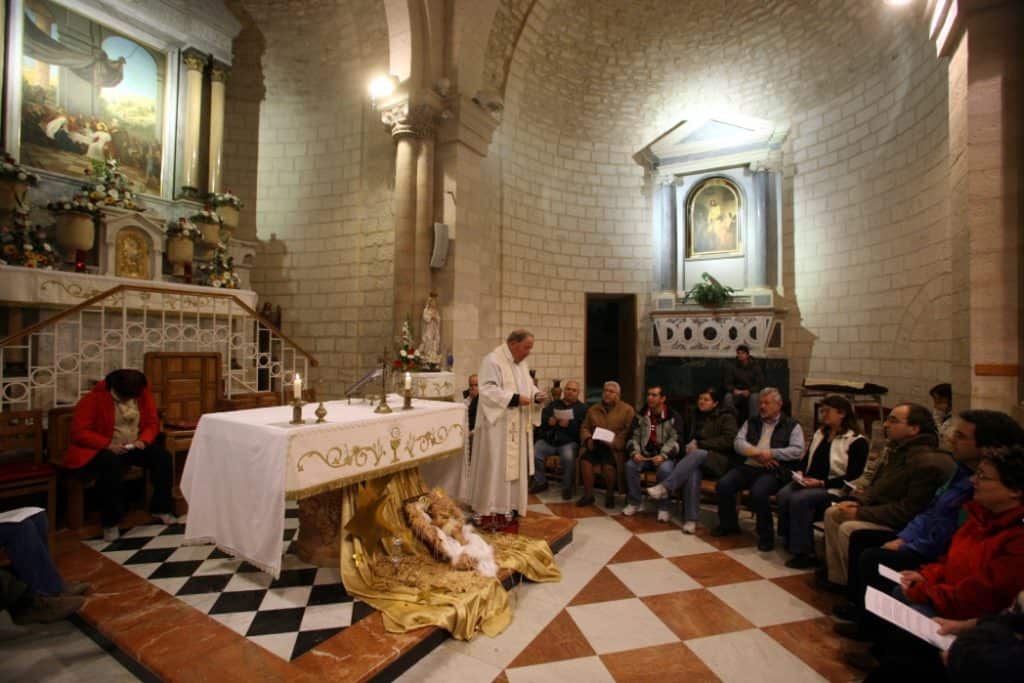The village of Cana in Israel is of great significance to Christians around the world. Located in the Galilee region, Cana is believed to be the site of Jesus’ first miracle, where he turned water into wine at a wedding feast.

This famous miracle in the Village of Cana is recorded in the New Testament. It’s seen as a symbol of Jesus’ compassion and generosity. Cana has been a place of pilgrimage for Christians for over two thousand years. Pilgrims come to Cana to retrace the footsteps of Jesus and to reflect on the significance of his first miracle.
Village of Cana: Where Jesus Heals an Official’s Son
In Cana, it’s told Jesus heals an official’s son:
“[…] so Jesus returned to Cana in Galilee, where he had turned water into wine. Meanwhile, in Capernaum, there was a government official whose son was ill. […] he went to him and asked him repeatedly to come down and heal his son because he was about to die. […] Jesus told him: “go home. Your son will live.” The man believed what Jesus told him and started back home.
(John 4: 46-54)

Credit: Chris06, CC BY-SA 4.0, via Wikimedia Commons
Jesus Calls Philip and Nathaniel
It is in the Village of Cana where one of the disciples of Jesus lived, none other but Nathaniel of Cana in Galilee:
“Philip found Nathaniel and told him, “we have found the man about whom Moses in the Law and the Prophets wrote – Jesus, the son of Joseph, from Nazareth.” Nathaniel asked him, “From Nazareth? Can anything good come from there?” Philip told him, “Come and see!” Jesus saw Nathaniel coming towards him and said to him, “Look a genuine Israeli, in. Whom there is no deceit!” Nathaniel asked him, “How do you know me?” Jesus answered him, “Before Philip called you, while were under the fig tree, I saw you.” Nathaniel replied to him, “Rabbi, you are the Son of God! You are the King of Israel!”
(John 1:45-49)
The Church of St. Bartholomew (Nathaniel) is placed today in the very heart of the Village of Cana. Tradition points to this location where Philip met with Nathaniel. Nearby there is also the Church of the Wedding, which Christian tradition points to as the church’s crypt, where two out of the six jars used for the miracle are placed there.

Locating the Village of Cana
The Gospel of John describes seven signs or miracles Jesus performed; each meant to reveal his divine nature and mission. These seven signs are considered among the most significant events in the life of Jesus and are central to the teachings of Christianity. The first one is when Jesus turned water into wine at a wedding feast in Cana.

Credit: RomanDeckert, CC BY-SA 4.0, via Wikimedia Commons
But there has been much speculation about where Cana might have been. The author does not claim to have been at the wedding in John. Many would regard the story of the wedding at Cana as theological rather than historical or topographical significance because it is significant as the first of the seven miraculous “signs” by which Jesus’s divine status is attested and around which the gospel is structured.
The primary Canindates As the New Testament Cana:
The village of Qana in Lebanon: Is about 18 miles (29 km) from Tyre. It is traditionally held to be the correct site by many Christians and is Eusebius’s pick in his 4th century Onomasticon. It is a popular tourist site commemorating the miracle.
Khirbet Kana (Israel): Other historical evidence from the Byzantine and Medieval periods shows that Khirbet Kana was regarded as the true site of New Testament Cana from a very early period. A guidebook written by Theodosius between 517 and 527 CE titled The Layout of the Holy Land identifies Khirbet Kana and indicates that two of the vessels were still at the location.
The Wedding at Cana

A pilgrim account written by Saewulf in 1101 to 1103 CE also identifies the site, as do Belard of Ascoli (c. 1155 CE) and Dominican friar Burchard of Mount Sion (1283 CE), and a map by noted cartographer Petrus Vesconte in 1321 CE. Burchard of Mount Sion describes a cave complex used as a veneration site: “the place is shown at this day where the six water pots stood, and the dining room where the tables were placed.”
Kafr Kanna (Israel): The first time this site is associated with New Testament Cana is in a mid-17th century report to the Pope.
Some scholars believe, according to archaeological evidence, that the identification of Kafr Kanna was the result of the decline of Khirbet Qana beginning in the Mamluk period. They note that it was a common practice for new and more affluent and easily accessible sites to be established in place of old ones to accommodate increases in pilgrim traffic, particularly in the late Medieval and Ottoman periods.







